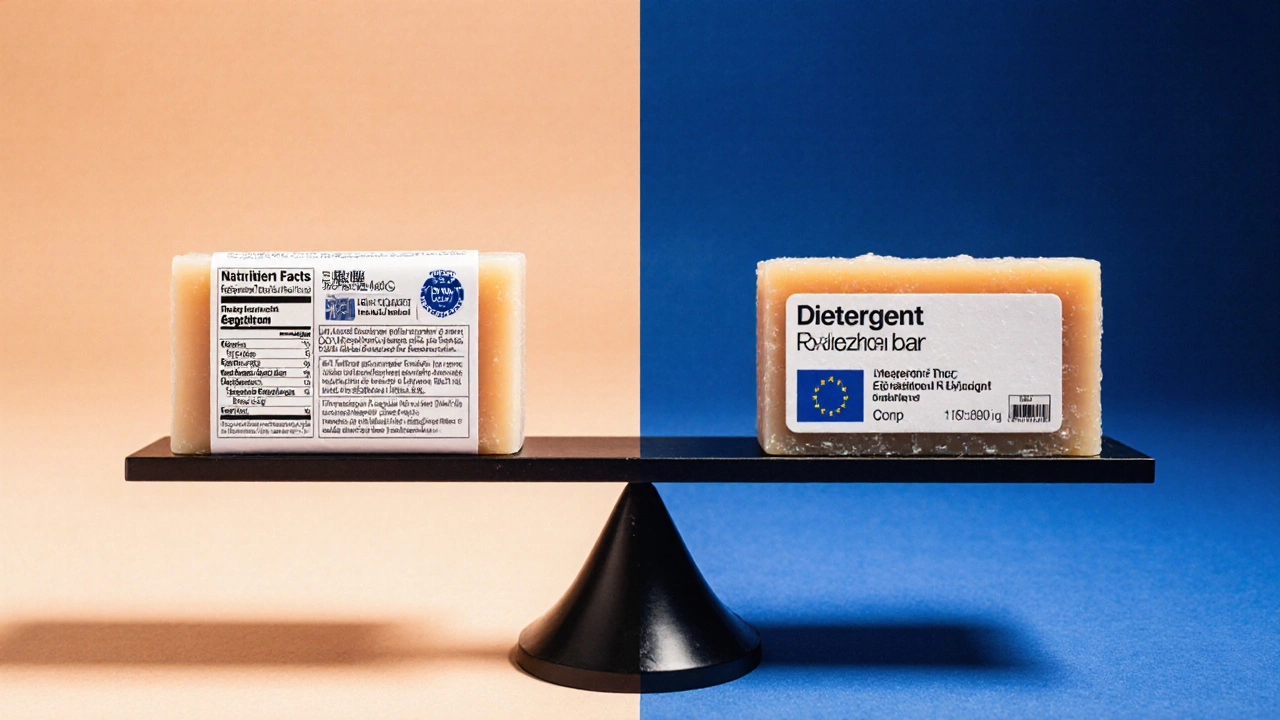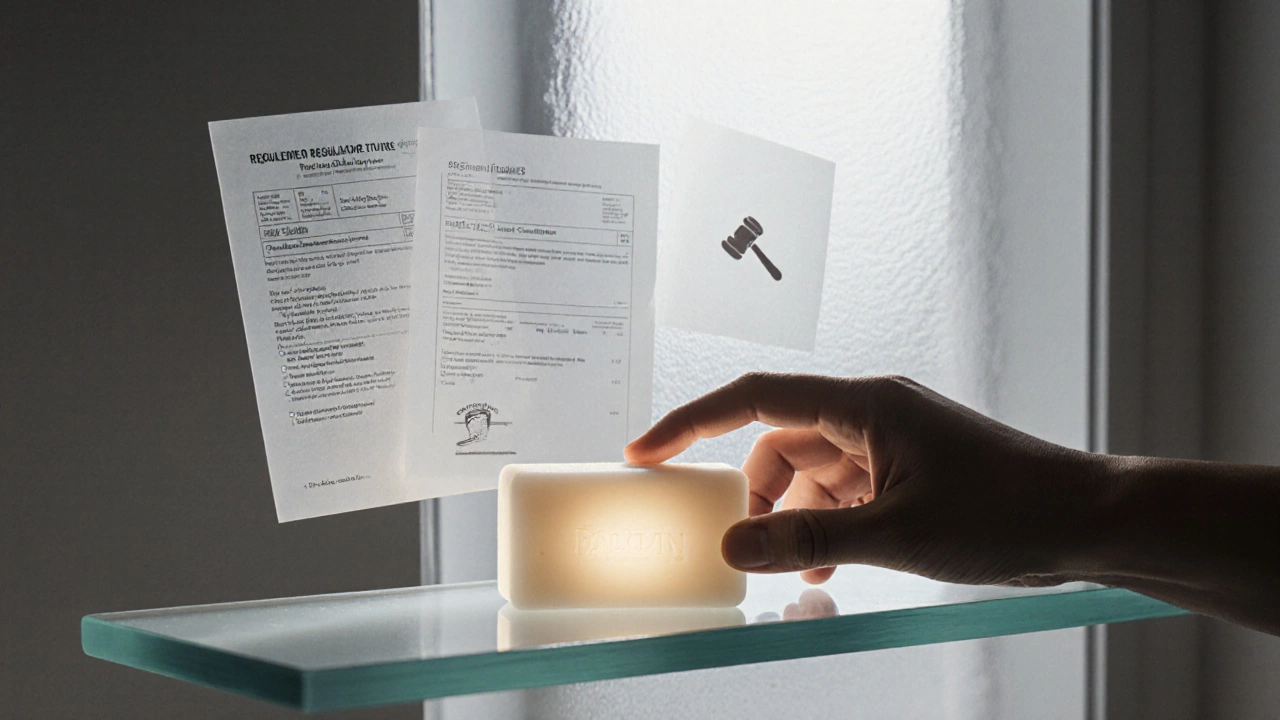Soap Classification Checker
Determine if your soap product would be classified as soap, cosmetic, or drug based on its ingredients and claims. This tool follows U.S. FDA and EU regulatory guidelines for cleansing products.
If your product contains antimicrobial ingredients and claims therapeutic benefits, it may be classified as an over-the-counter drug in the US or a medicinal product in the EU.
Products with claims like "kills 99% of germs" or "reduces acne" typically cross into drug classification territory.
When you grab a bar of soap a cleansing bar made from fats or oils combined with an alkali in the shower, you probably assume it’s just there to wash away dirt. But the line between a simple cleanser and a regulated cosmetic can be blurrier than you think. Below, we untangle the legal definitions, compare the rules in the U.S. and Europe, and show you why the answer matters whether you’re a consumer, a small‑batch maker, or a big brand.
Key Takeaways
- In the United States, soap is generally regulated as a cosmetic unless it makes a therapeutic claim.
- The European Union treats ordinary soap as a cosmetic under Regulation (EC) No1223/2009, while detergent‑based cleansing bars fall under a different set of rules.
- Antimicrobial or medicated soaps may be classified as over‑the‑counter (OTC) drugs, triggering stricter labeling and ingredient limits.
- Labeling requirements differ by jurisdiction but always demand an ingredient list, a net‑weight statement, and any necessary warnings.
- Manufacturers can avoid costly re‑classification by checking purpose, base ingredients, and the claims they make on the packaging.
What Exactly Is a "Cosmetic Product"?
In plain language, a cosmetic is anything you apply to your body to clean, beautify, or alter its appearance without affecting its structure or functions. The U.S. Food and Drug Administration the federal agency that oversees food, drugs, cosmetics, and medical devices defines a cosmetic as a product intended for "cleansing, beautifying, promoting attractiveness, or altering the appearance" of the skin, hair, nails, or teeth.
Across the Atlantic, the EU Cosmetics Regulation Regulation (EC) No 1223/2009 governing cosmetic products in the European Union uses similar language but adds that a cosmetic must not have a primary therapeutic purpose.
These definitions matter because they dictate which agency reviews the product, what safety data you must submit, and how the label should look.
How Soap Fits Into the Cosmetic Definition
Traditional soap is made by saponifying fats or oils with an alkali (like sodium hydroxide). The resulting molecule has a hydrophilic head and a hydrophobic tail, letting it lift oil and dirt from the skin. Because its primary function is cleaning, most regulators slot it under the cosmetic umbrella.
However, not all bar cleansers are created equal. There are three common categories you’ll encounter on a label:
- True soap - made primarily from fatty acid salts.
- Detergent‑based cleansing bars - use synthetic surfactants (like sodium lauryl sulfate) instead of fatty acid salts.
- Antimicrobial or medicated soap - contain active ingredients such as triclosan, chlorhexidine, or benzoyl peroxide.
In the U.S., the first two are generally treated as cosmetics. The third group can be re‑classified as a over‑the‑counter drug a drug sold without a prescription that treats minor health issues, which triggers a whole new set of FDA rules.
U.S. Regulation: FDA’s View on Soap
The FDA does not require pre‑market approval for cosmetics, but it does enforce labeling and safety standards. If a soap makes a claim like “reduces acne” or “prevents infection,” the agency may consider it a drug. In that case, the product must have an approved New Drug Application (NDA) or meet the OTC monograph criteria.
Key points for U.S. makers:
- Keep claims limited to cosmetic language - “cleanses,” “moisturizes,” “gives a fresh scent.”
- Provide a full ingredient declaration on the back label.
- Include any required warnings (e.g., “For external use only,” “Keep out of reach of children”).
- Maintain records of safety testing for each ingredient; the FDA can request them at any time.

European Perspective: EU Cosmetics Regulation
Under the EU rule, any solid or liquid product intended for cleansing or beautifying the skin is a cosmetic unless it has a medicinal purpose. This includes traditional soap and many synthetic‑surfactant bars.
Detergent‑based bars that primarily rely on synthetic surfactants are still cosmetics, but they also need to meet the EU’s Detergents Regulation for certain ingredients (like phosphates). The two regimes overlap, so a product may be subject to both sets of rules.
For manufacturers targeting the EU market, the steps are:
- Compile a Product Information File (PIF) a comprehensive dossier containing safety assessments, ingredient specs, and labeling proof.
- Appoint a Responsible Person (RP) a legal entity based in the EU who ensures compliance.
- Submit the product to the EU’s Cosmetic Products Notification Portal (CPNP) before it hits shelves.
When Soap Becomes a Drug
Antimicrobial soaps are the most common gray area. If the product contains an FDA‑approved active ingredient (e.g., chlorhexidine an antiseptic used in wound cleaning) and claims to reduce or prevent infection, it steps into drug territory.
What that means for you:
- Manufacturers must follow the OTC monograph the set of rules governing over‑the‑counter drugs in the U.S., which dictates permissible concentrations, labeling warnings, and required testing.
- In the EU, similar products are regulated under the Medicinal Products Directive the legal framework for medicines in Europe.
If a brand wants to avoid the drug classification, it can either remove the active ingredient or re‑phrase the claim to stay within cosmetic language (e.g., “helps reduce surface bacteria” vs. “kills 99% of germs”).
Labeling Essentials for Soap as a Cosmetic
Whether you’re in the U.S., EU, or elsewhere, certain labeling elements are non‑negotiable:
| Element | U.S. (FDA) | EU (Cosmetics Regulation) |
|---|---|---|
| Product identity | Must clearly state "soap" or "cleansing bar" | Same requirement, plus language must be in the official EU language of the market |
| Net weight | Weight in ounces or grams | Net weight in grams |
| Ingredient list | INCI names in descending order | INCI names in descending order |
| Warning statements | e.g., "Avoid contact with eyes" | Must include any required safety warnings per Annex I |
| Manufacturer/contact info | Name and address of the responsible firm | Same, plus a EU responsible person if applicable |
For detergent‑based bars, you may also need to list the surfactant concentration if it exceeds certain thresholds. The EU’s Detergents Regulation requires a separate statement for phosphates, non‑ionic surfactants, and any biodegradable claims.
Practical Checklist for Makers
- Identify the base: fatty‑acid salts (true soap) or synthetic surfactants (detergent‑based).
- Define the intended claim: cleaning vs. therapeutic.
- Cross‑check each active ingredient against FDA and EU drug monographs.
- Prepare a Product Information File the safety dossier required in the EU if you plan to sell there.
- Draft label copy that meets both regions’ ingredient and warning requirements.
- Run a final compliance review with a regulatory consultant before launch.
This list reduces the risk of expensive reformulations or product recalls down the line.

What Consumers Should Look For
When you pick up a bar in the store, the label can tell you a lot about its regulatory status:
- Ingredient transparency - A full INCI list suggests the product is being treated as a cosmetic.
- Therapeutic claims - Phrases like “kills 99.9% of germs” likely indicate a drug classification.
- Regulatory symbols - In the EU, a “CE” mark isn’t required for cosmetics, but you’ll see a “CPC” (Cosmetic Product Compliance) number on compliant products.
- Warnings - Look for “for external use only” or “keep out of reach of children” - these are mandatory for both cosmetics and drugs.
If you have sensitive skin or allergies, the ingredient list is your best friend. True soaps tend to be gentler because they lack harsh synthetic surfactants, but they can be more alkaline, which may irritate some skin types.
Comparison Table: Soap, Cosmetic, Detergent, and Drug
| Category | Primary purpose | Base ingredients | Typical regulator | Label claim limits |
|---|---|---|---|---|
| True soap | Cleansing | Fatty‑acid salts | FDA (US) / EU Cosmetics Reg. | Cosmetic‑only language |
| Detergent‑based bar | Cleansing | Synthetic surfactants | FDA / EU Detergents Reg. | Cosmetic language; may need surfactant % |
| Antimicrobial soap | Disinfection | Active antiseptic + soap base | FDA (OTC) / EU Medicinal Dir. | Therapeutic claims allowed only with OTC |
| Medicated skin cream | Treatment | Active drug + base | FDA (Drugs) / EU Medicinal | Full drug claims, dosing instructions |
Frequently Asked Questions
Is any bar that cleans the skin automatically a cosmetic?
Most bars are treated as cosmetics if they only claim to cleanse, moisturize, or freshen. Once a therapeutic claim appears, the product may shift to drug status.
Do I need to register my handmade soap with any agency?
In the U.S., registration isn’t required, but you must keep safety records and follow labeling rules. In the EU, you must submit a Product Information File to the CPNP before selling.
Can I label my antibacterial soap as "soap" or must I call it a "hand sanitizer"?
If the product’s main function is to clean and the antimicrobial claim stays within the OTC monograph limits, you can retain the term "soap" but you must include the appropriate drug warnings.
What’s the difference between a cosmetic ingredient list and a drug ingredient list?
Cosmetic lists use INCI names and order by concentration. Drug lists must also include the active pharmaceutical ingredient (API) with its strength and may require a separate pharmacological description.
If I sell my soap online internationally, do I need to comply with both U.S. and EU rules?
Yes. Each market enforces its own regulations. The safest route is to meet the stricter of the two - typically the EU’s documentation requirements - and adjust label language per country.
Next Steps for Makers and Buyers
Got a product idea? Start by drafting a clear purpose statement. Then, map your ingredients against the FDA’s cosmetic ingredient database and the EU’s prohibited list. If any claim hints at a health benefit, run it by a regulatory consultant before printing the label.
For shoppers, a quick glance at the back of the bar can tell you if you’re buying a simple cleanser or a regulated drug. Stick to products that list all ingredients and avoid vague “clinically proven” claims unless they’re backed by a drug label.
Understanding where soap sits in the regulatory landscape empowers you to make safer choices - whether you’re formulating in a kitchen lab or picking up a bar at the supermarket.
